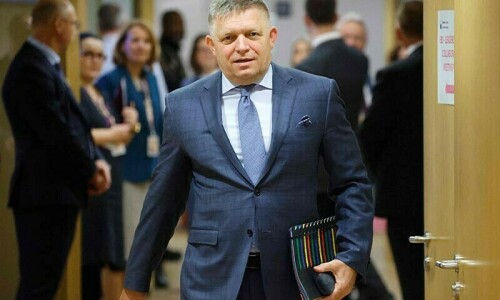ISLAMABAD: Annual consumer inflation slightly eased to 8.90 per cent during the outgoing fiscal year (FY21) from previous year’s 10.74pc, showed data released by the Pakistan Bureau of Statistics on Thursday.
Inflation slightly fell to 9.7pc in June from 10.9pc in May mainly because of improvement in supply of food items and reduction in prices of essential kitchen items. Inflation remained in double digits from March to May 2021. It was mainly driven by a double-digit growth in food inflation in both urban and rural areas.
On a month-on-month basis, inflation increased by 0.2pc. Food and non-food items prices are still on the higher side.
Average Consumer Price Index (CPI) is expected to remain between 7pc and 9pc next year.
At the beginning of the current fiscal year, consumer inflation was recorded at 9.3pc in July, declining to 8.2pc in August before rebounding to 9pc in September. From September, inflation went on a downward trajectory, giving some relief to the end consumers. However, it rebounded in February.
A few consumer items, as well as energy prices, pushed up inflation in March again, with the result that food inflation entered double digits in both urban and rural areas. There are food items the prices of which are still on an upward trajectory.
Prices of food group rose 11pc year-on-year but declined 1.9pc month-on-month in June in urban areas. The situation is almost the same in rural areas where prices of food group rose 9.8pc year-on-year and declined 0.8pc month-on-month in June. The month-on-month decline indicates that there will be a let-up in prices of essential food items next month.
The government has imported wheat and sugar to bridge shortfalls and improve supplies in the market. The government imported 3.612 million tonnes of wheat between July and March this year against zero import last year. No import of wheat was made in April, May and June.
The government has already announced that it will import around four million tonnes of wheat to keep a buffer stock. Estimates show a bumper wheat production of over 27m tones this year.
Similarly, import of sugar stood at 280,772 tonnes during 11 months of the current fiscal year as against 6,210 tonnes over the corresponding period last year.
With the arrival of potatoes, tomatoes and onions in the domestic market due to good crops, their prices declined last month.
In urban areas, the food items which saw a jump in prices in June from the previous month included tomatoes (28.94pc), onions (14.97pc), eggs (4.37pc), vegetables (3.11pc), meat (2.85pc), gur (1.85pc), wheat (1.52pc), vegetable ghee (1.36pc), pulse masoor (1.26pc) and mustard oil (1.21pc). The items whose prices declined in urban areas were chicken (36.86pc), fruits (20.07pc), pulse moong (6.10pc), fish (1.91pc), pulse gram (1.82pc) and pulse mash (1.24pc).
In rural areas, prices of tomatoes rose by 26.76pc, vegetables 9.09pc, eggs 4.27pc, mustard oil 3.11pc, wheat 3.11pc, gur 2.49pc, milk 2.20pc and cooking oil by 1.23pc.
Non-food inflation in urban centres saw an increase of 8.9pc year-on-year and 0.6pc month-on-month, whereas in rural areas it rose by 9.7pc and declined by 0.6pc, respectively. The month-on-month increase in non-food inflation indicates a further increase in coming months as the government has passed on the increase in prices of petroleum products to end consumers.
The urban CPI covers 35 cities and 356 items, while the rural one tracks 27 centres and 244 products. The former grew by 9.7pc year-on-year in June and the latter by 9.7pc.
Core inflation in urban areas was recorded at 6.7pc in June, compared to 6.8pc the previous month. In rural areas, it was recorded at 7.3pc in June as against 7.6pc the previous month.
The State Bank of Pakistan determines the key policy rate, currently at 7pc, based on the core inflation rate. The central bank has reduced the rate by a cumulative 625 basis points since March 17, 2020 to combat uncertainty amid the coronavirus pandemic.
Contrary to this, the wholesale price inflation eased to 9.41pc during the outgoing fiscal year against 10.24pc the previous year. The Wholesale Price Index-based inflation rose to 20.9pc in June from 19.4pc a month earlier.
Average inflation measured by the Sensitive Price Index surged to 13.83pc in FY21 from 13.74pc the previous year. The SPI in June was recorded at 17.6pc against 19.7pc a month earlier.
Published in Dawn, July 2nd, 2021















































